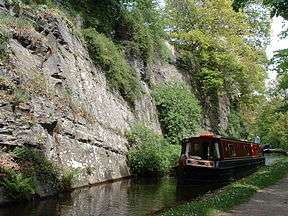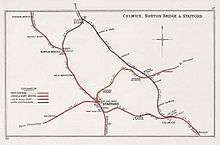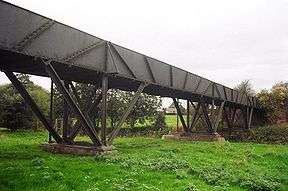Shropshire Union Railways and Canal Company
The Shropshire Union Railways and Canal Company was a Company in England, formed in 1846, which managed several canals and a railway. It was leased by the London and North Western Railway from 1847, and bought by it in 1922, but continued to act as a semi-autonomous body, managing the canals until their abandonment in 1944. With the passing of the Railways Act 1921 (Grouping Act) the company became part of the London, Midland and Scottish Railway (LMS).
History
Shropshire Union Canals | ||||||||||||||||||||||||||||||||||||||||||||||||||||||||||||||||||||||||||||||||||||||||||||||||||||||||||||||||||||||||||||||||||||||||||||||||||||||||||||||||||||||||||||||||||||||||||||||||||||||||||||||||||||||||||||||||||||||||||||||||||||||||||||||||||||||||||||||||||||||||||||||||||||||||||||||||||||||||||||||||||||||||||||||||||||||||||||||||||||
|---|---|---|---|---|---|---|---|---|---|---|---|---|---|---|---|---|---|---|---|---|---|---|---|---|---|---|---|---|---|---|---|---|---|---|---|---|---|---|---|---|---|---|---|---|---|---|---|---|---|---|---|---|---|---|---|---|---|---|---|---|---|---|---|---|---|---|---|---|---|---|---|---|---|---|---|---|---|---|---|---|---|---|---|---|---|---|---|---|---|---|---|---|---|---|---|---|---|---|---|---|---|---|---|---|---|---|---|---|---|---|---|---|---|---|---|---|---|---|---|---|---|---|---|---|---|---|---|---|---|---|---|---|---|---|---|---|---|---|---|---|---|---|---|---|---|---|---|---|---|---|---|---|---|---|---|---|---|---|---|---|---|---|---|---|---|---|---|---|---|---|---|---|---|---|---|---|---|---|---|---|---|---|---|---|---|---|---|---|---|---|---|---|---|---|---|---|---|---|---|---|---|---|---|---|---|---|---|---|---|---|---|---|---|---|---|---|---|---|---|---|---|---|---|---|---|---|---|---|---|---|---|---|---|---|---|---|---|---|---|---|---|---|---|---|---|---|---|---|---|---|---|---|---|---|---|---|---|---|---|---|---|---|---|---|---|---|---|---|---|---|---|---|---|---|---|---|---|---|---|---|---|---|---|---|---|---|---|---|---|---|---|---|---|---|---|---|---|---|---|---|---|---|---|---|---|---|---|---|---|---|---|---|---|---|---|---|---|---|---|---|---|---|---|---|---|---|---|---|---|---|---|---|---|---|---|---|---|---|---|---|---|---|---|---|---|---|---|---|---|---|---|---|---|---|---|---|
Legend
| ||||||||||||||||||||||||||||||||||||||||||||||||||||||||||||||||||||||||||||||||||||||||||||||||||||||||||||||||||||||||||||||||||||||||||||||||||||||||||||||||||||||||||||||||||||||||||||||||||||||||||||||||||||||||||||||||||||||||||||||||||||||||||||||||||||||||||||||||||||||||||||||||||||||||||||||||||||||||||||||||||||||||||||||||||||||||||||||||||||

In 1844, the Ellesmere and Chester Canal Company, which owned the broad canals from Ellesmere Port to Chester and from Chester to Nantwich, with a branch to Middlewich, began discussions with the narrow Birmingham and Liverpool Junction Canal, which ran from Nantwich to Autherley, where it joined the Staffordshire and Worcestershire Canal. The two companies had always worked together, in a bid to maintain their profits against competition from the railways, and amalgamation seemed to be a logical step. An agreement was worked out by August, and the two companies then sought an Act of Parliament to authorise the takeover. This was granted on 8 May 1845, when the larger Ellesmere and Chester Canal Company was formed.[1]
Reformation as a joint canal - railway company
Almost immediately, a committee was set up to look at options for converting all or part of the canals into railways, and extending the network. Although they had already tried using a steam tug to haul a train of boats, they realised that not all of their canals were suitable for such use, and that a locomotive on a railway with good gradients offered a better solution. The Staffordshire and Worcestershire Canal were alarmed by the announcement that many of the canals might close, on the basis that removal of one would have a serious effect on another, and sought to oppose the action.[2]
However, the joint company obtained an Act of Parliament in 1846, which reformed it as the Shropshire Union Railways and Canal Company (SUR&CC). The 1846 Act authorised the new company to take over the Shrewsbury Canal and to buy the Montgomery Canal and the Shropshire Canal.[3] The intent behind the 1846 Act was to build railways at a reduced cost, by using the existing routes of the canals they owned.[4] In 1847, the Company agreed to the terms of a lease from the London and North Western Railway Company (LNWR), and so lost its independence after little more than a year, but continued to manage the canals under its control.[5]
By 1849, the plan to turn the canals into railways had been dropped.[4] From the same year, the Company leased the Shropshire Canal, which ran from Doddington Wood where there was a junction with the Trench branch of the Shrewsbury Canal, to Coalport, on the River Severn;[5] they eventually purchased it in 1854.
Because the canals were largely in areas which were served by railways owned by the Great Western Railway, the LNWR was more than happy for it to continue to expand, and it remained profitable until the start of the First World War, in 1914. The Shropshire Union acted as a carrier, as well as managing the canals; they owned 213 narrowboats in 1870, rising to 395 in 1889 and 450 in 1902.[4]
Takeover by the LNWR
In 1921, the company sold most of their boats to private carriers, and made economy measures in a bid to reduce the regular losses they were making. The LNWR bought out the company in 1922, but was taken over by the new London Midland and Scottish Railway Company immediately afterwards.
A period of steady decline set in, with reduced maintenance making it more difficult for boats to operate. A breach near Frankton Junction on the Montgomery Canal, in 1936, effectively closed that branch.
Finally, an Act of Abandonment was obtained in 1944, which resulted in the closure of 175 miles (280 km) of canal, leaving only the main line from Ellesmere to Autherley, and the branch to Middlewich. The branch to Llangollen was also retained, but only as a feeder to supply water to the canal. The other main sources of water were the Belvide Reservoir, near the A5 road at Brewood, and the outflow from the Barnhurst Sewage Treatment Works at Autherley Junction.[4]
Shropshire Union Railways



The Shropshire Union Company constructed and ran one of the few railways in England which were built by a canal company. The railway was the Stafford to Shrewsbury Line, via Newport and Wellington. The SUR&CC were solely responsible for the section from Stafford to Wellington; but the building and operation of the 10.5 mile (17 km) long Shrewsbury to Wellington section was shared with the Shrewsbury and Birmingham Railway.[6][7]
After the LNWR take over of the SUR&CC, the Shrewsbury and Wellington Railway was operated as a Joint railway by the Great Western Railway and the LNWR.[7] The Stafford to Shrewbury Railway opened on 1 June 1849 and was 29.25 miles (47 km) in length.[8] The London and North Western Railway leased the line from July 1847, before it was complete.
The Shropshire Union Railways today
The Shrewsbury and Wellington section is still in use today by Arriva Trains Wales.
Passenger services on the Stafford to Wellington section ended on 7 September 1964. Goods services ceased between Stafford and Newport on 1 August 1966 and this branch from Wellington was cut back to Donnington on 22 November 1969.
In June 2009, the Association of Train Operating Companies, in its Connecting Communities; Expanding Access to the Rail Network report (which proposed a £500m scheme to open 33 stations on 14 lines closed in the Beeching Axe, including seven new parkway stations) identified the line from Stafford to Wellington as potential link that could feasibly be re-opened.[9][10]
The canals today

As of 2007, the main line from Ellesmere Port to Autherley and the branch to Middlewich are still open; they are known as the Shropshire Union Canal. The branch to Llangollen has been reopened for navigation, having been promoted as suitable for pleasure boating from the mid-1950s, and has been re-branded as the Llangollen Canal.
The Montgomery Canal has been partially re-opened. The first section restored was at Welshpool, when the line of the canal was threatened by a bypass. This isolated section was reopened in 1969. The section southwards from Frankton Junction has been restored and opened progressively since 1987, with additions in 1996, 2003, 2007 and the latest stretch from Redwith Bridge to Pryce's Bridge in July 2014. There are ongoing efforts to complete the restoration of most of the remaining un-navigable sections.[4]
A Trust has been set up to conserve the remains of the Shrewsbury Canal, with a view to reopening it in the longer term.[11] A feasibility study and a detailed engineering report have been commissioned and completed, and conclude that there are no major engineering obstacles to a full reopening.[12][13]
A minor section of the Shropshire Canal including the Hay Inclined Plane has been incorporated into the Ironbridge Gorge Museums.
References
- ↑ Hadfield 1985, pp. 188–189
- ↑ Hadfield 1985, pp. 231–232
- ↑ Shropshire Routes to Roots: Section 8
- 1 2 3 4 5 Nicholson Waterways Guide Volume 4 (2006), Harper Collins Publishing Ltd, ISBN 0-00-721112-0
- 1 2 Shropshire Routes to Roots: Section 9
- ↑ Wolverhampton University: The Shrewsbury & Birmingham Railway
- 1 2 Casserley, H. C. (1968). Britain's Joint Lines. London: Ian Allan. ISBN 0-7110-0024-7
- ↑ Awdry, Christopher (1990). Encyclopaedia of British Railway Companies. London: Guild Publishing. Pp 42, 102 & 103.
- ↑ "Connecting Communities - expanding access to the rail network" (PDF). London: Association of Train Operating Companies. June 2009. p. 21. Archived from the original (pdf) on 29 July 2013. Retrieved 20 February 2015.
- ↑ "BBC NEWS - England - Operators call for new rail lines". BBC News. 15 June 2009. Retrieved 2009-06-15.
- ↑ The Shrewsbury and Newport Canals Trust
- ↑ Trust news report, quoting Inland Waterways Association annual report 2006.
- ↑ Full 2006 IWAC report here - see p43
Further reading
- Hadfield, Charles (1969). The Canals of The West Midlands. 2nd Edition. Newton Abbot: David & Charles. ISBN 0-7153-4660-1.
- Rolt, L. T. C. (1970). The Inland Waterways of England. 5th Impression. London: George Allen and Unwin Ltd. ISBN 0-04-386003-6.